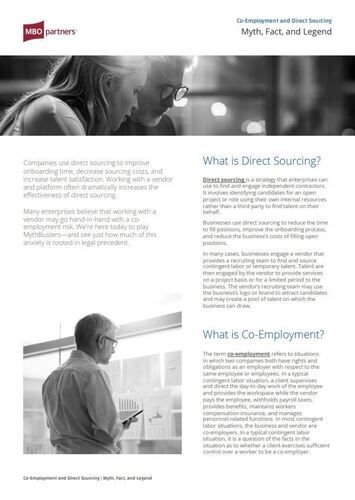Co-Employment and Direct Sourcing:
Myth, Fact, and Legend
Want to continue reading this article?
Companies use direct sourcing to improve onboarding time, decrease sourcing costs, and increase talent satisfaction. Working with a vendor and platform often dramatically increases the effectiveness of direct sourcing.
Many enterprises believe that working with a vendor may go hand-in-hand with a co-employment risk. We’re here today to play MythBusters—and see just how much of this anxiety is rooted in legal precedent.
What is Direct Sourcing?
Direct sourcing is a strategy that enterprises can use to find and engage independent contractors. It involves identifying candidates for an open project or role using their own internal resources rather than a third party to find talent on their behalf.
Businesses use direct sourcing to reduce the time to fill positions, improve the onboarding process, and reduce the business’s costs of filling open positions.
In many cases, businesses engage a vendor that provides a recruiting team to find and source contingent labor or temporary talent. Talent are then engaged by the vendor to provide services on a project basis. or for a limited period to the business. The vendor’s recruiting team may use the business’s logo or brand to attract candidates and may create a pool of talent on which the business can draw.
GATE
What is Co-Employment?
The term co-employment refers to situations in which two companies both have rights and obligations as an employer with respect to the same employee or employees. In a typical contingent labor situation, a client supervises and direct the day-to-day work of the employee and provides the workspace while the vendor pays the employee, withholds payroll taxes, provides benefits, maintains workers compensation insurance, and manages personnel-related functions. In most contingent labor situations, the business and vendor are co-employers. In a typical contingent labor situation, it is a question of the facts in the situation as to whether a client exercises sufficient control over a worker to be a co-employer.
What’s the Difference between Co-Employment and Joint Employment?
The terms co-employment and joint employment are often used interchangeably. Most statutes and regulations use the term joint employment, but co-employment is used more commonly in the industry. While there may be technical differences between the terms, this paper uses the term co-employment which includes most, if not all, relevant joint employment situations.
Am I an Employer or Not?
For there to be co-employment, there must first be employment. Whether a worker is an employee of a business (as opposed to an independent contractor) can be determined by reviewing the factors in the United States Supreme Court in Nationwide Mut. Ins. Co. v. Darden, 503 US 318 (1992). The court said that the primary factor for determining if a worker is an employee is whether the business controls the manner and means by which the work is performed. Other factors that are relevant include:
- The skill required
- The source of the instrumentalities and tools
- The location of the work
- The duration of the relationship between the parties
- Whether the business has the right to assign additional projects to the hired party
- The extent of the business’s discretion over when and how long to work;
- The method of payment
- The business’s role in hiring and paying assistants
- Whether the work is part of the regular business of the business
- Whether the business provides employee benefits
- How the business treats the worker from a tax perspective
The court said that all the factors need to be weighed and no one factor is decisive.
Recruiting by a vendor and/or sharing a business’s logo with a vendor is not factor that affects whether a worker is an employee or not or shows that the business controls the worker. The primary question —whether the business exercises control over the worker or not – is not affected by sharing a logo and/or using a vendor to recruit a worker does not demonstrate control.
Co-Employer or Not?
Agencies and regulations provide different standards for when an entity is a co-employer or joint employer.
- Equal Employment Opportunity Commission’(EEOC). Contingent workers typically qualify as employees of the vendor, “the client to whom they are assigned, or both.” An entity will qualify as the worker’s employee if, “one or both businesses have the right to exercise control over the worker’s employment.” Enforcement Guidance: Application of EEO Laws to Contingent Workers Placed by Temporary Employment Agencies and Other Staffing Firms, EEOC Notice, Number 915.002 (Dec. 3, 1997). The most important consideration is, “the right to control the means and manner of her work performance rests with the firm and/or its client rather than with the worker herself.” The EEOC goes on to state the entire working relationship must be assessed.
- Department of Labor (DOL) Family and Medical Leave Act (FMLA). “Where two or more businesses exercise some control over the work or working conditions of the employee, the businesses may be joint employers under FMLA….A determination of whether or not a joint employment relationship exists is not determined by the application of any single criterion, but rather the entire relationship is to be viewed in its totality. For example, joint employment will ordinarily be found to exist when a temporary placement agency supplies employees to a second employer.” 29 C.F.R. § 825.106
- DOL Fair Labor Standards Act (FLSA). For a long time, the DOL regulation said that two entities were not joint employers unless, “employment by one employer is not completely disassociated from employment by the other employer(s).” The Trump administration DOL issued a rule that narrowed the circumstances in which two businesses would be considered joint employers. A business would only be a joint employer if it actually exercised control over a worker—it was not enough that the business had the right to exercise control. The Biden administration DOL has rescinded the Trump DOL joint employer rule and has not proposed a new rule yet.
- Nation Labor Relations Board (NLRB). For a long time, the NRLB considered businesses to be “joint employers” if they shared or co-determined the essential terms and conditions of employment and exercised the right to control. The NLRB consists of five (5) members appointed by the President and its approach changes when the administration changes. In 2015, the NLRB eliminated the requirement that a business exercised control. In 2017, the NLRB reverted to the standard that required a business to have exercised control over a worker. Most commentators expect the NLRB under President Bident to adopt a standard that expands the broadened standard and makes it more likely that a business is considered a joint employer.
Recruiting and/or sharing of logos is not a factor in any of the co-employer tests. There is no suggestion that direct sourcing has any effect on whether a business is a co-employer or not. The primary question is the extent of the control that the business exercises over the worker.
Co-Employment—Much Ado About Nothing
Being a co-employer does not create any liability in and of it itself. If a worker files a lawsuit alleging that a business was a co-employer, the lawsuit would be dismissed with a big “So what?” Being a co-employer only means that a business exerts some control over a worker.
Exerting control over a worker is just one of several flags to determine if a worker qualifies as an independent contractor. When engaging via a qualified workforce management platform, such as MBO Partners, a worker’s classification status is evaluated and determined to maintain compliance against legal issues such as worker misclassification, which can result in brand damage, hefty fines, and legal penalties.
The Benefits of Co-Employment
While many businesses are afraid of being a co-employer, there are significant benefits to being a co-employer.
- Workers’ Compensation is Employee’s Exclusive Remedy. If a worker is injured at a business’s location, the worker may be able to sue the business unless the worker is an employee in which case the worker is limited to making a claim under workers’ compensation.
- Hostile Work Environment Claims. If a worker makes claim that the manager of a business has created a hostile work environment, an employer (and co-employer) can avoid liability if it can provide that, “1) it reasonably tried to prevent and promptly correct the harassing behavior; and 2) the employee unreasonably failed to take advantage of any preventive or corrective opportunities provided by the employer.” For a business that is not a co-employer, then the business may be liable to the worker.
A Business Controls Its Co-Employment Destiny
A business controls its co-employment destiny—whether it is co-employer or not—by the amount of control it exercises over a worker. Where, when, how, and by whom the worker is recruited or whether the business uses a vendor to recruit or shares its logo does not factor in the co-employment determination. A business becomes a co-employer by exerting control over a worker—supervising the work, providing training, or specifying the manner and means by which the work is to be performed.
The Direct Sourcing—Co-employment Myth: Busted
By reviewing the factors that determine when a business is a co-employer, it is easy to see that direct sourcing does not present a co-employment risk—it is a myth that direct sourcing increases as business’s risks with respect to co-employment.
About The Author: Eric Rumbaugh, Partner, Michael Best
Eric is a Partner at Michael Best, where he leads a recognized practice in the area of contingent labor and regularly prepares and reviews policies, procedures and contracts and litigates contested matters for users and providers of temporary employees, consultants, independent contractors and other contingent talent.
Eric is a prominent national speaker and writer and regularly presents and writes on employment law topics. He also teaches a course on co-employment for Staffing Industry Analysts.

Understand key differences between co-employment and direct sourcing
Related Articles
Effective Communication in Your Direct Sourcing Program
Like the employee portion of the workforce, your independent talent network is not a homogeneous group. The communication…
Read MoreWhy Use a Direct Sourcing Strategy for Talent Acquisition
Many companies today are turning to direct sourcing as a strategy for independent talent acquisition. Direct sourcing helps…
Read MoreHow to Increase Direct Sourcing Program Adoption
Direct sourcing often has a positive impact on enterprises. It allows managers to source talent internally rather than…
Read More

